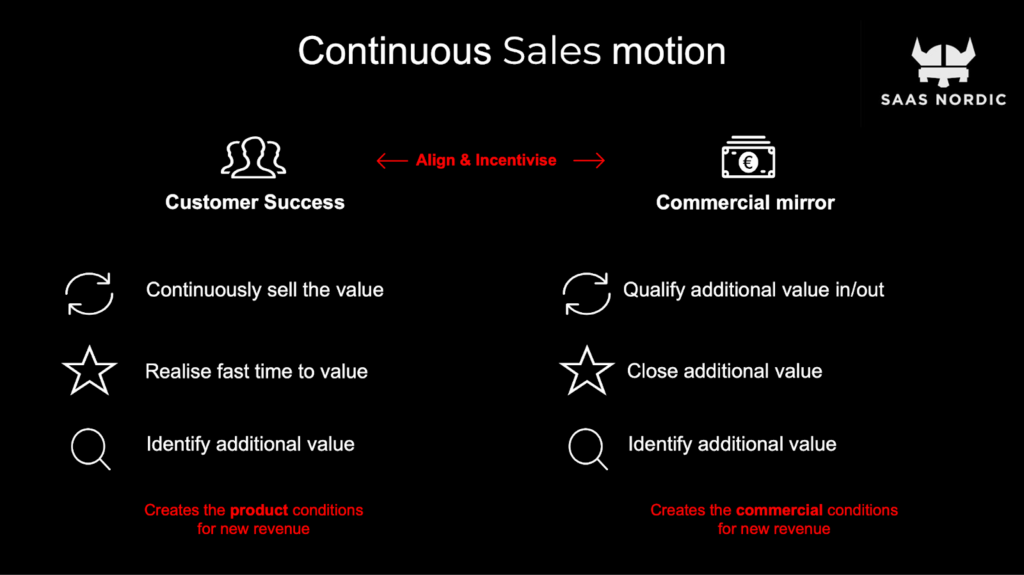“Recovering software executive” and venture capital investor and advisor Rav Dhaliwal contends that there is a missing piece in how we do software sales, and you’re leaving money on the table because of it.
Takeaways:
- Our selling approach is still linear despite fundamental changes in how SaaS products are built, distributed, configured, and used.
- Customer success is predominantly focused on retaining revenue as opposed to growing revenue.
- The key is to create a continuous selling motion that focuses on delivering a quick time-to-value, continuously selling the value, and identifying additional value opportunities.
- You need to mirror the AE/SE team (prospect phase) that brought in the first sale with an AM/CSM team (growth phase) that will bring in the next sale. Align and incentivize them.
- Make the necessary cultural changes to how CS is viewed within the organization and how they operate (including targets, forecasting, trends, involvement in key deals, pods, and training).
Software has changed dramatically, but selling hasn’t
When the world first started selling enterprise software several decades ago, clients paid upfront to own the software on-premise, then spent another year or two implementing it. It was a large capital infrastructure investment with a lot of sunk cost, making it expensive and difficult to switch vendors. And, this being the case, the old sales orthodoxy told us that the sales team’s job was done when a customer signed on the dotted line.
But now we’ve dramatically changed the way we build software and the way we distribute it. Own the software? Ha! You can rent from us annually or maybe even monthly. Deployment is replaced by configuration and, in some cases, not even that. Buy a subscription, and we flip a switch (or a computer does it for us). We live in an API world in an API economy, so switching from one solution to the other is nowhere near as painful as it used to be. And, most importantly, today customers are making an operating expenditure, not a capital expenditure.
Customer success is still largely focused on retaining, not growing revenue
The challenge today is that we’re in the cloud world, but still using the same linear go-to-market production sales line. For some reason, we still consider the sales team’s job complete at contract signature, even though we didn’t get the money upfront, and then we bolt on customer success (CS) at the end and assume all the problems associated with SaaS will be solved.
Even the best-functioning customer success functions in companies across the world are still in a defensive posture. They’re predominantly there to retain the revenue, not being proactive in helping to grow revenue, which is critical since new business is getting tougher and tougher in the current climate.
So why is it that the orthodox sales methodology with CS bolted on is no longer fit-for-purpose? It’s because the orthodox sales world focuses on only two types of selling: inbound and outbound. What it doesn’t cater to is the third type of selling: continuous selling. And this is the missing piece in software sales.
The missing piece: continuous selling
Every successful SaaS company derives the majority of their revenue from their existing customer base. In a continuous sales motion, we need to focus on continuously selling customers the value of what they’ve bought, and customers need to realize real value quickly with a minimal amount of effort on their part.
The window for them to see value is small: 30 to 90 days max. That gives you the largest possible window by which to work with customers on identifying additional areas of value, which translate to more productivity for them and more revenue for you.
This should be the focus of every good functioning success team: driving the maximum amount of product health and product value such that they can create the conditions for a commercial person to drive more revenue. And so in a continuous sales motion, we need to change the emphasis of our CS team from being revenue-defensive to being defensive and offensive.
Mirror roles in CS with commercial roles for subsequent sales
CS should be focused on delivering fast time-to-value so you can mirror them with a commercial person, which could be the original seller or an account manager, whose responsibility is to qualify and close those additional value opportunities, such as more consumption, more adoption, different products, and so forth.
It takes technical skill, product skill, and sales skill – the same set of skills used to make the original sale – to do renewals and upsells. So we need to align people and incentivize them.

In the first sale, you generally have an account executive as the commercial owner paired with a sales engineer. They are typically aligned on a common territory, and they have shared incentives. We pay our sales engineers for deal closure, but they do not close the deal. They enable the deal to happen.
Similarly, to make the next sale, we need to mirror that arrangement. We need to have a commercial owner, like an account manager (or the same AE), and the sales engineer’s mirror is the customer success manager. Align them on the same territory and make sure that their incentives overlap such that the AM can’t get fully paid unless their CS colleague is successful and CS can’t get fully paid unless their AM colleague is successful.
There are essentially two teams: a sales team focused on new revenue and ACV and a growth team focused on net revenue retention. In this model, there’s no such thing as pre-sales or post-sales, just a continuous selling motion that will create a flywheel of continuous revenue.
How to drive change
To build a continuous selling motion, there need to be some cultural changes. Founders need to stop viewing CS as a service-oriented group for defensive revenue protection, and they need to give CS some material net revenue retention targets, such as product adoption or usage metrics that lead to value realization, including time-to-value. Get them to forecast these metrics regularly in addition to quarter-on-quarter and year-on-year trends.
Train them the same way you train your sales and sales engineering teams. Why? Because there are an AE, SE, AM, and a CSM all working the same book of business, and they’re doing roughly the same things – trying to get access to stakeholders, trying to understand business problems, trying to get new people into the business.
And attach them to key deals. Make sure they’re part of the discussion towards the end of the deal so they’re starting to do discovery on how they can drive that fast time-to-value.
To hear Rav present on how to drive this growth mindset, mosey on over to SaaSiest TV to watch his full presentation.




